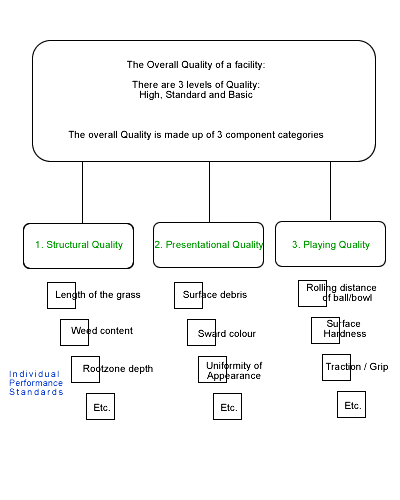Flat rink bowls is typically played on a square bowling green, with each side being 38.4m (42 yards) in length, however, this can vary from between 30.2m (33 yards) and 40.2m (44 yards).
Rink size can range from 14 - 19 feet (4.27 - 5.79m) for casual play and 18 - 19 feet (5.49 - 5.79m) for competition play, with each green typically having six rinks marked for play.
The playing season generally begins at the end of April and extends until the end of September, or the beginning of October. Most competitions for outdoor bowls have been completed by the middle of September, with the majority of players then moving to the indoor bowls scene. Relatively little play takes place after the middle of September on outdoor bowling greens.
Quality
Greens should ideally be even and level throughout, with no undulations or depressions. The surface should also be firm and with a complete coverage of desirable grasses.
To ensure that a bowling green is maintained correctly, not only during the playing season but throughout the whole of the year, a number of individual performance standards are ideally set. The combination of these standards determines the overall quality of the bowling green.
Diagram to Illustrate Quality and Individual Standards

The setting of these performance standards provides a means of objectively assessing the quality of the bowling green.
Most users wish to have a first class bowling green, however, the true cost in materials, machinery and especially the skills of a qualified and experienced greenkeeper do not come cheap. Realistically the aim is for a good bowling green which is managed in a cost-effective manner.
This means that usage has to be managed to ensure wear is spread evenly throughout the whole green and 'favourite' rinks (which are generally not the end rinks) are not permitted as a matter of course, but are used as part of the overall management policy of spreading wear evenly.
This is a sensible approach as it can prevent the development of bowling runs on the green, which arguably favour poor quality bowling. This can also give an unfair advantage to home players over visitors due to their knowledge of these runs: This is unsportsmanly conduct and should not be permitted.
The actual maintenance cost for a bowling green will depend on a number of variables, in particular what is actually included within the so called true cost as some costs are hidden within other charges, especially when comparing local authority costs. A like for like comparison can be notoriously difficult to achieve.
